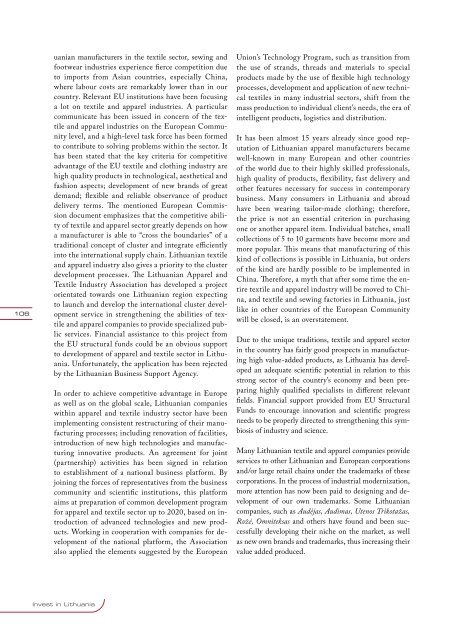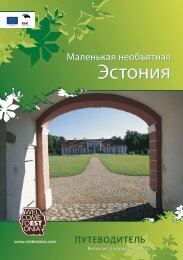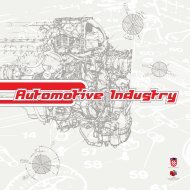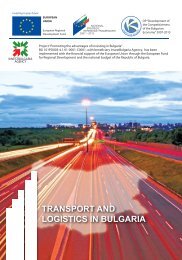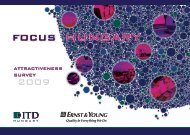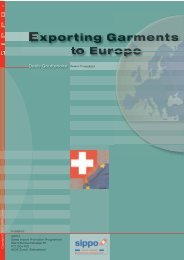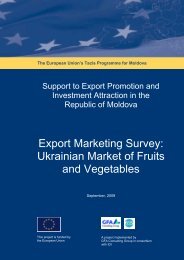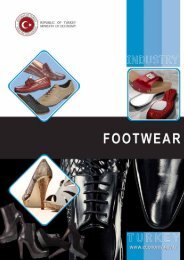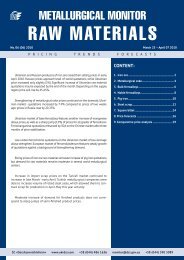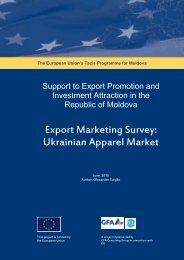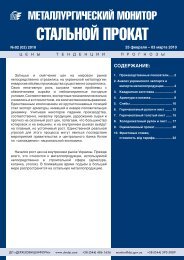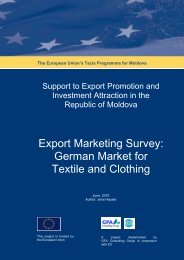(FEZ) - Industry Park & Logistic Centre
(FEZ) - Industry Park & Logistic Centre
(FEZ) - Industry Park & Logistic Centre
Create successful ePaper yourself
Turn your PDF publications into a flip-book with our unique Google optimized e-Paper software.
106<br />
uanian manufacturers in the textile sector, sewing and<br />
footwear industries experience fierce competition due<br />
to imports from Asian countries, especially China,<br />
where labour costs are remarkably lower than in our<br />
country. Relevant EU institutions have been focusing<br />
a lot on textile and apparel industries. A particular<br />
communicate has been issued in concern of the textile<br />
and apparel industries on the European Community<br />
level, and a high-level task force has been formed<br />
to contribute to solving problems within the sector. It<br />
has been stated that the key criteria for competitive<br />
advantage of the EU textile and clothing industry are<br />
high quality products in technological, aesthetical and<br />
fashion aspects; development of new brands of great<br />
demand; flexible and reliable observance of product<br />
delivery terms. The mentioned European Commission<br />
document emphasizes that the competitive ability<br />
of textile and apparel sector greatly depends on how<br />
a manufacturer is able to “cross the boundaries” of a<br />
traditional concept of cluster and integrate efficiently<br />
into the international supply chain. Lithuanian textile<br />
and apparel industry also gives a priority to the cluster<br />
development processes. The Lithuanian Apparel and<br />
Textile <strong>Industry</strong> Association has developed a project<br />
orientated towards one Lithuanian region expecting<br />
to launch and develop the international cluster development<br />
service in strengthening the abilities of textile<br />
and apparel companies to provide specialized public<br />
services. Financial assistance to this project from<br />
the EU structural funds could be an obvious support<br />
to development of apparel and textile sector in Lithuania.<br />
Unfortunately, the application has been rejected<br />
by the Lithuanian Business Support Agency.<br />
In order to achieve competitive advantage in Europe<br />
as well as on the global scale, Lithuanian companies<br />
within apparel and textile industry sector have been<br />
implementing consistent restructuring of their manufacturing<br />
processes; including renovation of facilities,<br />
introduction of new high technologies and manufacturing<br />
innovative products. An agreement for joint<br />
(partnership) activities has been signed in relation<br />
to establishment of a national business platform. By<br />
joining the forces of representatives from the business<br />
community and scientific institutions, this platform<br />
aims at preparation of common development program<br />
for apparel and textile sector up to 2020, based on introduction<br />
of advanced technologies and new products.<br />
Working in cooperation with companies for development<br />
of the national platform, the Association<br />
also applied the elements suggested by the European<br />
Invest in Lithuania<br />
Union’s Technology Program, such as transition from<br />
the use of strands, threads and materials to special<br />
products made by the use of flexible high technology<br />
processes, development and application of new technical<br />
textiles in many industrial sectors, shift from the<br />
mass production to individual client’s needs, the era of<br />
intelligent products, logistics and distribution.<br />
It has been almost 15 years already since good reputation<br />
of Lithuanian apparel manufacturers became<br />
well-known in many European and other countries<br />
of the world due to their highly skilled professionals,<br />
high quality of products, flexibility, fast delivery and<br />
other features necessary for success in contemporary<br />
business. Many consumers in Lithuania and abroad<br />
have been wearing tailor-made clothing; therefore,<br />
the price is not an essential criterion in purchasing<br />
one or another apparel item. Individual batches, small<br />
collections of 5 to 10 garments have become more and<br />
more popular. This means that manufacturing of this<br />
kind of collections is possible in Lithuania, but orders<br />
of the kind are hardly possible to be implemented in<br />
China. Therefore, a myth that after some time the entire<br />
textile and apparel industry will be moved to China,<br />
and textile and sewing factories in Lithuania, just<br />
like in other countries of the European Community<br />
will be closed, is an overstatement.<br />
Due to the unique traditions, textile and apparel sector<br />
in the country has fairly good prospects in manufacturing<br />
high value-added products, as Lithuania has developed<br />
an adequate scientific potential in relation to this<br />
strong sector of the country’s economy and been preparing<br />
highly qualified specialists in different relevant<br />
fields. Financial support provided from EU Structural<br />
Funds to encourage innovation and scientific progress<br />
needs to be properly directed to strengthening this symbiosis<br />
of industry and science.<br />
Many Lithuanian textile and apparel companies provide<br />
services to other Lithuanian and European corporations<br />
and/or large retail chains under the trademarks of these<br />
corporations. In the process of industrial modernization,<br />
more attention has now been paid to designing and development<br />
of our own trademarks. Some Lithuanian<br />
companies, such as Audėjas, Audimas, Utenos Trikotažas,<br />
Rožė, Omniteksas and others have found and been successfully<br />
developing their niche on the market, as well<br />
as new own brands and trademarks, thus increasing their<br />
value added produced.


